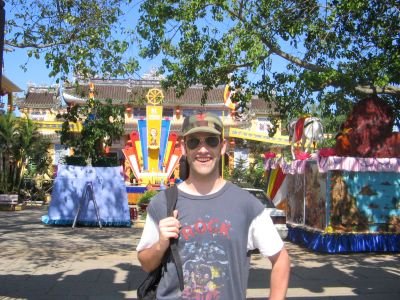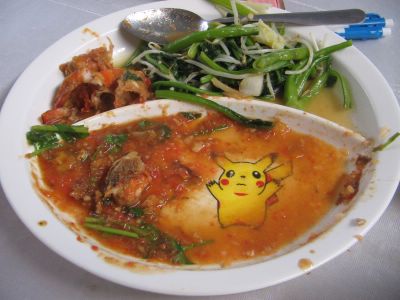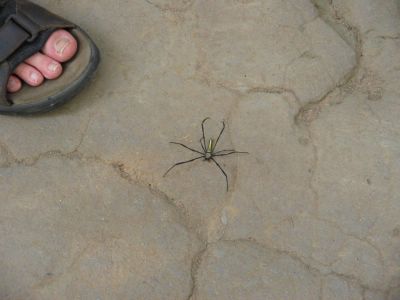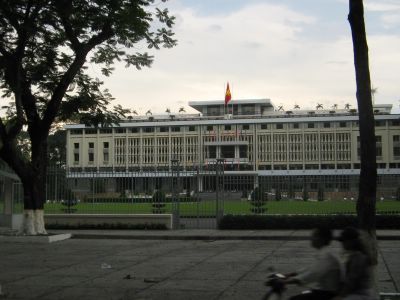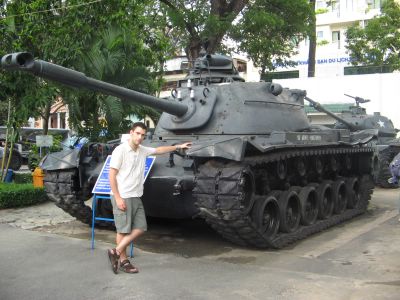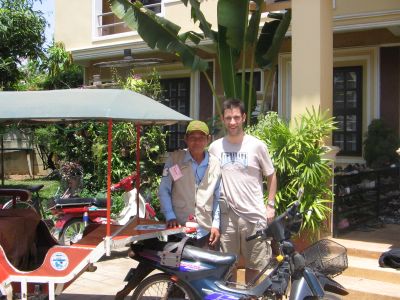12 May 2006
Here Today, Sai Gon Tomorrow
The journey to Ho Chi Minh City (HCMC) took over two days and went like this:
- From Siem Reap, we got a bus to Phnom Penh at 12.30 (good road) and arrived at 19.00.
We booked into a cheap (ie $3) 'lakeside' guesthouse, and decided that the piddling fan that failed to blow through our mosquito net, coupled with lack of air con, meant that we wouldn't sleep in the heat, so drank beer in hammocks until 03.00. - At 07.00 we took a minibus to a boat on the Mekong (poor road), which arrived at 10.00.
- The boat arrived at the border into Vietnam at 12.30, where we alighted, had our passports stamped, hastily scoffed down to some noodle soup and were underway on a different boat (four deckchairs on a long flat hull, covered by a makeshift awning) by 13.00.
- We were dropped off at Chau Doc by 15.30 and were on another minibus to HCMC (crap road followed by appalling road followed by inexplicably bad dual carriageway into HCMC) by 16.00, which arrived at 22.00.
- We found a delightful guesthouse run by giggling Vietnamese girls and were grateful to crawl into a comfortable bed, cooled by a roaring a/c.
That day we hopped on a night train to Nha Trang, a beach resort, for a bit of a holiday before heading off again for more arduous travelling. We went scuba diving yesterday, and I did two half-hour dives. Twas blue in blue.
We leave tonight. We overnight on the train again and arrive in Hoi An late tomorrow morning.
07 May 2006
Angkor What?
This I have only encountered twice before. Once in St. Peter's Basilica in Rome and the other was the Taj Mahal. You may never have heard of the Temples of Angkor, but, if the figures are to be believed, this is one of the world's must-sees whose profile is burgeoning at an alarming rate. 451,046 tickets were sold in 2004. This rose to 690,987 in 2005. This is alarming because the Cambodian government turned the site, previous under the jurisdiction of archaeologists, over to its tourist board, and by the time this nation, poor as it is, realises the benefit of investing in the upkeep of its most valuable asset, it may be too late. As it stands, most of the upkeep is funded and carried out by foreign NGOs and universities - mostly German and Japanese.
I have been feeling a little guilty for having posted nothing in the last while, but I think that, due to the amount we have been packing in to every day, our trip to Angkor feels like it was infinity-plus-one days ago. Honestly, I have actually been dreading writing this post. Occasionally something escapes my descriptive abilities and when this happens I think I'll wait until some time in the future, when I'm asked, preferably in a pub, with a pint of Guinness in front of me, to describe a place or an experience that doesn't lend itself to a dirty keyboard in a third world internet-hovel (cf. the train station in Calcutta). My post on Varanasi (which was written in a back street in Varanasi, in a shack, which was deriving its electricity from a generator, on account of a power cut) is an example of when I forced myself, and it nearly finished me off. This may be similar, so I'm going to be brief. Ask me about it in June.
We got a bus to Siem Reap, Angkor's nearby town. We had the privilege of being driven by bus down a fairly passable road of which the Cambodians are immensely proud. When aske
 d how one found the "very good road", one is obliged to nod sagely and agree that it is "excellent". We found a really nice guesthouse called Smiley's which did the most spectacular fresh pineapple juice. The town was quite relaxed and there were some good bars and restaurants. We ate a hot Indian.
d how one found the "very good road", one is obliged to nod sagely and agree that it is "excellent". We found a really nice guesthouse called Smiley's which did the most spectacular fresh pineapple juice. The town was quite relaxed and there were some good bars and restaurants. We ate a hot Indian.Curry that is.
The first evening we went to the main attraction - the temple called Angkor Wat - to watch it as the sun set. It changed colour from a noble stone to a fiery red and, as the ageless eye of Phaeton once more dipped below the distant horizon, the ancient edifice was silhouetted against the dusky tropical sky. Or at least that's what had happened the day before. When we were there it was cloudy, so it just sorta got dark.
The sun rose with a vengeance the next morning. We asked a guy to be our driver for the next two days and he told us where we could go. To the temples, of course. There's Angkor Wat, which is the largest and most impressive. This is near to what used to be a town of almost one million inhabitants, known as Angkor Thom. Only royalty was allowed to build with stone, so the wooden houses have rotten away to leave a hugely impressive collection of temples and palaces, in varying states of decay, within the old city walls.
 The pictures will hopefully speak for themselves, but they can't do the place justice. Angkor Wat is sculpted all over. At one stage Deirdre sat down on a stone along the causeway to read something from the Lonely Planet. I was aghast and asked her kindly not to sit on the finely crafted Khmer architecture. However, a quick glance around for an appropriate surface left us with nothing but finely crafted Khmer architecture, so we shrugged and plonked ourselves where we were.
The pictures will hopefully speak for themselves, but they can't do the place justice. Angkor Wat is sculpted all over. At one stage Deirdre sat down on a stone along the causeway to read something from the Lonely Planet. I was aghast and asked her kindly not to sit on the finely crafted Khmer architecture. However, a quick glance around for an appropriate surface left us with nothing but finely crafted Khmer architecture, so we shrugged and plonked ourselves where we were.As I mentioned before, this place I can only compare in grandeur to two other buildings that I have experienced. Although less decorative than the Vatican or Taj Mahal, Angkor Wat outstrips these two buildings for two reasons:
- Firstly and most obviously, is twice as old as either of the others, dating from the 12th century.
- Secondly, it is miles away from anywhere. The population figures are thought to be wildly exaggerated. These are estimated from inscriptions on the temples themselves, describing how many people were required for their upkeep. One of the bigger temples (but not one of the big three - Angkor Wat, Bayon and Ta Phrom) claims to have required 80,000 for its upkeep, including clergy, dancers and the like. Imagine a very large football stadium full to capacity. Now think about fitting them all into a temple, let alone running it. So they're big filthy liars; Angkor Thom was not that populous but is still that isolated, and they managed to drag all that rock (because these things are never built of local rock, presumedly so future generations can marvel at the fact that an army of men had to drag it from miles away) and build big stuff.
The gallery is now ready. The linkis located at the top right of this page.
I think the heat is getting to me and I still haven't done my 'dramatically-tie-the-opening-paragraph-to-the-closing-one-by-posing-a-series-of-ridiculous-rhetorical-questions-bit' yet.
So now you know about Angkor. Or do you? Can one really know a place  without experiencing it? Will Angkor Wat still be standing when you get out from behind that computer and see it for yourself? Was that really a rhetorical question? Or that? Who knows? That one was definitely rhetorical. I mean - that one was definitely rhetorical?!?
without experiencing it? Will Angkor Wat still be standing when you get out from behind that computer and see it for yourself? Was that really a rhetorical question? Or that? Who knows? That one was definitely rhetorical. I mean - that one was definitely rhetorical?!?
Enough of this foolishness. For a better description of stuff without all the prevarication, look at Dee's blog. The link is at the top left of this page. I warn you, it's pink.
We are now in Ho Chi Minh City, after a hellish journey. Well, hellishish. I'll explain in my next post. The general plan is to go to the beach in Nha Trang for a few days.
Tootles.
Toby.
